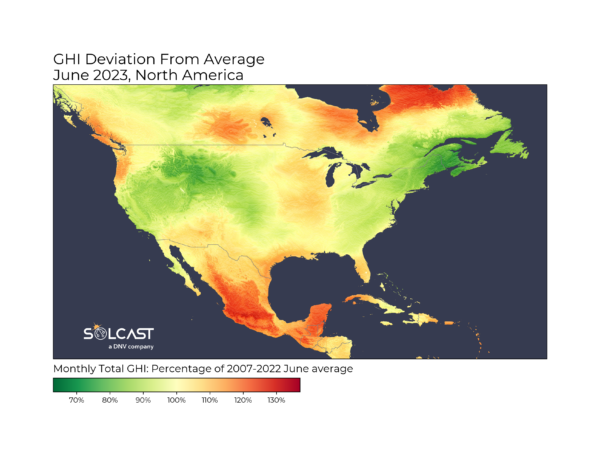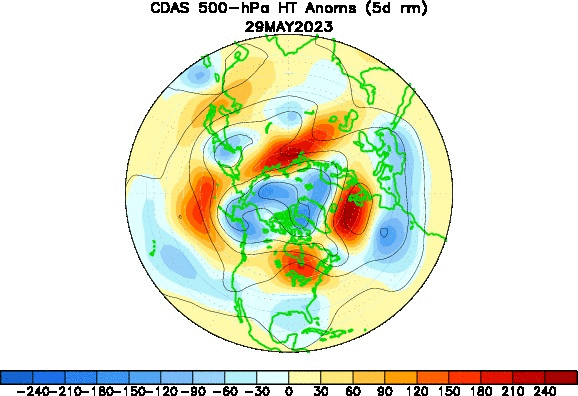In a new weekly update for pv magazine, Solcast, a DNV company, presents the solar irradiance data it collected for June, which showed that Mexico, the US Southwest and Midwest, and Canada received significantly above average solar irradiance. The enhanced solar generation was particularly welcome in Mexico and the Southwest, where it helped meet higher electricity demand caused by record-breaking heatwaves.
June 30, 2023 Solcast
Data collected by Solcast, a DNV company, via its Solcast API Toolkit, showed that Mexico, the US Southwest and Midwest, and Canada received significantly above average solar irradiance during June. The surplus reached as high as 30% over parts of Mexico and Quebec. The enhanced solar generation was particularly welcome in Mexico and the Southwest, where it helped meet higher electricity demand caused by record-breaking heatwaves.
The pattern of June irradiance anomalies was caused by a persistent region of high pressure over northern Canada, which also extended over the Pacific Northwest during the second half of the month. This deep, stationary region of high pressure limited or “blocked” the usual approach of weather systems from the west, causing hot and dry air to build up over Mexico and the Southwest, and preventing usual outbreaks of cool and cloudy weather across Canada and the Midwest.
 GHI Anomalies in North America in June 2023
GHI Anomalies in North America in June 2023
Image: Solcast
Periods of regional storm activity led to cloudier than average conditions over California, the West and the Northeast during June, with solar resource reaching as low as 20-30% below average in Montana and Maine.
In Florida, storms and low pressure from the north Atlantic also led to major floods and the closure of several hydroelectric dams. Solar generation potential for this month remained at roughly the long-term expected June value due to sunny periods between storms, but the reduced hydroelectric storage and generation capacity introduces challenges in managing the variability of solar production.

Anomalous high pressure region (red) over northern Canada and the Pacific Northwest
Image: Solcast
Looking ahead for North America, El Niño was officially declared by National Oceanic and Atmospheric Administration (NOAA) during June, with a likelihood of developing into a moderate to strong event at its expected peak from November to January. El Niño events typically bring wetter, cloudier weather to Mexico and the southern United States during winter.
Solcast produces these figures by tracking clouds and aerosols at 1-2km resolution globally, using satellite data and proprietary AI/ML algorithms. This data is used to drive irradiance models, enabling Solcast to calculate irradiance at high resolution, with typical bias of less than 2%, and also cloud-tracking forecasts. This data is used by more than 300 companies managing over 150GW of solar assets glob ally.
The views and opinions expressed in this article are the author’s own, and do not necessarily reflect those held by pv magazine.
This content is protected by copyright and may not be reused. If you want to cooperate with us and would like to reuse some of our content, please contact: [email protected].
>>> Read full article>>>
Copyright for syndicated content belongs to the linked Source : PV-Magazine – https://www.pv-magazine.com/2023/06/30/high-pressure-block-brings-sunshine-and-heat-to-mexico-us-midwest-south-and-canada/





























